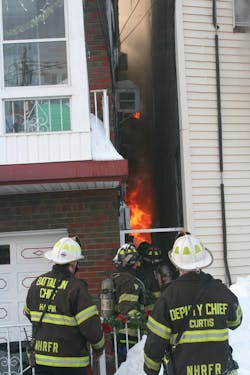Each year, I take one opportunity to use this column for opinion, as opposed to a “close call” case study. As always, we have plenty to share in 2012 and will return to our usual format in March. YOUR department’s close call is welcome as a submission. I work with departments to ensure the facts are presented so others may learn. To submit a CLOSE CALL, please contact me at [email protected]. This month, however, I wanted to pass along some thoughts I hope will be of value.
I’ve always been one to react emotionally to any harm toward a fire department or firefighters. It usually works well when talking with firefighters – it’s the non-firefighters who never seem to get it. It took me a while to figure that out, despite numerous warning signs. Ignoring emotion in a business where people lose people isn’t always easy.
The emotion that we share comes from the bad stuff we experience as firefighters, but elected officials and others do not. I am not aware of any fire department that’s not been hit by economic problems – we are losing people, training dollars and resources, and we’re even losing a lot of senior firefighters who are “getting out” when they can, fearing their retirements will be messed with. What we’re seeing in the fire service now is an erosion of experience and training, and with it the potential quality of firefighters. Departments need resources to get the job done, but on the other side of the cutbacks is the fact that we all know that many of the fires we are responding to today are burning quicker and buildings are collapsing quicker. We know these fires are much more dangerous – or we should.
That doesn’t mean we don’t do the job. It means we need to be as best trained and educated as possible and match that with the resources we have and the conditions we encounter. We need to be really good at basic tasks such as size-up (the basis for everything we do), forced entry, search and especially getting water on the fire. What does it take to get water on the fire in any building your company may respond to? What’s the plan? How much water will be needed? How will it get done and how many firefighters are realistically needed to get that done? How long will it take? What is needed to make it take less?
On top of all this, we are continuing to be beaten down by politics, politicians and local and national home builders associations using lies to minimize or defeat our opportunities to sprinkler buildings. Events in 2011 should have been a wake-up call to us of a perfect storm that is being created – and in 2012, some fire departments could be heading right into it. Many have less staffing, fewer resources, less understanding of the types of buildings we are responding to and less chance of beating the fire earlier through a lack of sprinkler systems.
How much more can firefighters do “with less”?
Doing “more with less” may work for the parks department or sanitation, but how it works for fire departments depends on conditions, existing resources, pre-fire preparedness and training. Actually, fire departments have ALWAYS done more with less. Those watching us just thought it was our norm. We have ALWAYS gone above and beyond; it is well documented. Now it’s even more, with even less, or so they are asking. With relation to cut resources, we (and “they”) all need to understand that we can only do so much with the resources we have. And a typical fire department’s “so much” is much more than any other local government resource. We know it. They know it. But they need to understand the facts from us – without emotion. Not easy.
We all want to crawl down the hall, do the search and knock down the fire, but we have to keep in mind that if we don’t have the political or public support to give us what is minimally needed, whether it’s funding, training or support for sprinkler systems, there is only so much we can do. We can only do as much as our resources and physical ability let us do. And that’s with us already going “above and beyond.”
We simply can’t get everything done when they have cut what we need TO DO everything. Of course, we need to be able to clearly and factually define what “everything” is when asked. For example, a first-alarm fire with 10 firefighters will not and cannot have the same results as that same fire getting 25 firefighters. Simple math; no emotion. But “they” need to understand that well before they start slicing the budget. Fire chiefs and commissioners must show courage and risk upsetting elected officials by telling them the truth – respectfully, factually and honestly. There have been too many headlines recently about fire chiefs stating that shutting stations or “brown-outs” will not impact service levels. How can they not?
Service WILL be impacted, and “they” must understand that – without emotion, using numbers. Response times, distance and tasks required. “They” must understand that there may be a measurable difference in people being rescued – and not being rescued – IN YOUR COMMUNITY, based on proposed cuts. Figure it out and educate them.
Don’t let cuts stop you
Despite cuts, we can still get some jobs done. If training budgets are cut, that doesn’t mean we stop training. Everyone has the Internet, and a lot of information can be gathered there at no cost to create classroom and hands-on training. We all have apparatus and tools, so we can go out and train on all the equipment we already have. We can train to the point of becoming “experts” on every procedure, tactic, hand tool or other piece of equipment we may have to use at our next run. Basic training can get done when we want to get it done. More than basic training costs more than basic money, so elected officials must decide what they want us to be able to do when their taxpayers have a really bad day. Show the elected officials and anyone else participates in these decisions the facts without emotion. When they digest the reality, they very well may create THEIR OWN EMOTION.
Of course, when we’re shutting companies, we can’t solve that kind of problem on the Internet. I know people get very emotional about this because our oath is to save lives and save property. Thirty-nine years ago, I took that oath. But let’s not be stupid. Our lives and property responsibilities aren’t equal. It’s far more important to attempt to save a life and far less so to save property and things. Anybody who doesn’t understand that is a danger to themselves and others. No boss should be putting a crew inside to save someone’s dress when it’s obvious the lightweight-truss house is ready to collapse, especially when resources may have been cut or have not yet arrived. I understand some may claim to be ready to put their lives on the line for a dress, but that’s why most fire departments encourage psychological testing prior to hire.
On the other hand, if the wearer of the dress is still inside and conditions indicate we may have a shot, we will absolutely take extreme risks. Odds are we are going in and will do whatever it takes. The point is that we may no longer be able to afford to do all the things we did before, with the measurable loss of resources some fire departments are faced with now. It can get emotional.
Making the right calls
Those who are quick to shout, “We should go in no matter what!” are those who have never had the responsibility for those who are going inside. When you’re a company officer and especially a command-level boss, your responsibility is much greater – to those on the fireground and in the building. They have to weigh stupid risk versus necessary risk. Sometimes, firefighters die in that process, doing a job that must be done with the risks that had to be taken. To think “no firefighter should die in the line of duty” is to clearly not understand the aspects of this risky job. There are times when everything is done to minimize risks and firefighters still die attempting to save a viable life. However, to think we should do our best so that no firefighter dies unnecessarily in the line of duty is probably more like it. Sometimes, firefighters die, but in the great majority of times, it was preventable. Sad and emotional, but it’s a fact.
Line firefighters who are told to “do this and not that” need to understand that the people making those decisions have been in their shoes as line firefighters. They may have grayer hair, but their experience matters and they’re the ones who have to make the decision. Think of a football team’s coaching staff. The coaches lead practices, develop game plans and “command, control and communicate” on the sidelines with the players operating on the “inside,” and based on their progress, strategy and tactics are applied. Certainly, players must deal with what they encounter on the field, but generally the rules, plays and training are what they follow. What the coaches direct is what the players do because of the coaches’ experience and qualifications. Following the coaches’ instructions is what players must do. It has worked well over the years on the field – and on the fireground. (For you younger firefighters, search “Coach Vince Lombardi” when you have a chance.)
Emotion and reality
A focus on learning about buildings before they are on fire and training before we have to use what we learn can go a long way. BEFORE the run comes in, size-up the buildings, your resources, your alarm assignments and whatever else you can understand and learn about – and size-up again when the run comes in.
With more facts and less emotion, we’ll have a better chance to do our jobs despite what some elected officials have in mind. By using facts, we can get them to understand or, better yet, develop their own concerns about the emotional facts and realities of fire protection for their constituents.






